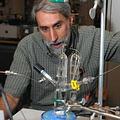 未來10年內,人們便能以太陽能電池(photovoltaic cells)在白天供應家庭用電,並使用多餘的太陽能水解水,生出氫氧並提供家用燃料電池電力。倘若麻省理工學院研發的新流程能讓市場接受,今日中央透過電線傳輸電力的方式,可能成為過去式。
未來10年內,人們便能以太陽能電池(photovoltaic cells)在白天供應家庭用電,並使用多餘的太陽能水解水,生出氫氧並提供家用燃料電池電力。倘若麻省理工學院研發的新流程能讓市場接受,今日中央透過電線傳輸電力的方式,可能成為過去式。
「多年來我們所談論的涅盤正是如此。」麻省理工學院的納薩拉(Daniel Nocera),在7月31日科學(Science)期刊的一篇論文中,描述這個簡單、廉價又有效率的太陽能儲存流程。
一直到現在,太陽能僅在白天使用,因為儲存額外太陽能供夜間使用很昂貴且沒有效率;但是納薩拉和他的研究團隊找到了一個漂亮的解決辦法。
納薩拉和他的博士後研究員卡南(Matthew Kanan)從植物的光合作用得到靈感,研發出這個利用太陽能來使水分解成氫氣和氧氣的新流程;氧和氫可以在燃料電池裡重新結合,不分日夜都能以無碳電力供應大樓、住戶或電動車用電。
這個新流程得以成功的關鍵在於一種新觸媒:可以分解水生成氧氣,由鈷、硫酸鹽和電極組成,放入水中;另一種觸媒可以產生氫氣。
從光電池或風渦輪機而來的電能流入電極,使鈷和硫酸鹽在電極表面形成薄膜和釋出氧氣。
加上另一個觸媒,例如白金,在分解水過程產生氫氣,這套流程使光合作用中的水解步驟出現兩次。
這個新觸媒可在室溫、中性水中反應,又容易架設,納薩拉說:「這就是為什麼這次會成功---整個流程太簡練了!」
納薩拉認為:「太陽能是最具解決能源問題的潛力。」地球一小時接收到的太陽能,足以供應一年能源所需。
納薩拉是切森家族基金會(Chesonis Family Foundation)贊助太陽能計畫主持人,和義大利能源集團Eni與MIT合作的太陽能中心(Eni-MIT Solar Frontiers center)副主任,他相信:「這下子科學家真的有得玩了!」
MIT能源所旨在將全球能源系統轉型至足以供應未來需求,並在當前技術和未來願景搭建橋樑,例如參與這份計畫。
這項計畫由國家科學基金會(NSF)和切森家族基金會(Chesonis Family Foundation)共同贊助,2008年春季已挹注1000萬美元推動太陽能計畫,希望達成10年內大規模應用太陽能目標。
Within 10 years, homeowners could power their homes in daylight with solar photovoltaic cells, while using excess solar energy to produce hydrogen and oxygen from water to power a household fuel cell. If the new process developed at the Massachusetts Institute of Technology finds acceptance in the marketplace, electricity-by-wire from a central source could be a thing of the past.
"This is the nirvana of what we've been talking about for years," said MIT's Daniel Nocera, senior author of a paper describing the simple, inexpensive, and efficient process for storing solar energy in the July 31 issue of the journal "Science."
Until now, solar power has been a daytime-only energy source, because storing extra solar energy for later use is expensive and inefficient. But Nocera and his team of researchers have hit upon an elegant solution.
Inspired by the photosynthesis performed by plants, Nocera and Matthew Kanan, a postdoctoral fellow in Nocera's lab, have developed a new process that will allow the Sun's energy to be used to split water into hydrogen and oxygen gases. Later, the oxygen and hydrogen can be recombined inside a fuel cell, creating carbon-free electricity to power buildings, homes or electric cars - day or night.
The key component in the new process is a new catalyst that produces oxygen gas from water - another catalyst produces valuable hydrogen gas. The new catalyst consists of cobalt metal, phosphate and an electrode, placed in water.
When electricity from a photovoltaic cell, a wind turbine or any other source runs through the electrode, the cobalt and phosphate form a thin film on the electrode, and oxygen gas is produced.
Combined with another catalyst, such as platinum, that can produce hydrogen gas from water, the system can duplicate the water splitting reaction that occurs in plants during photosynthesis.
The new catalyst works at room temperature, in neutral pH water, and is easy to set up, Nocera said. "That's why I know this is going to work. It's so easy to implement," he said.
Sunlight has the greatest potential of any power source to solve the world's energy problems, said Nocera. In one hour, enough sunlight strikes the Earth to provide the entire planet's energy needs for one year.
"This is just the beginning," said Nocera, principal investigator for the Solar Revolution Project funded by the Chesonis Family Foundation and co-Director of the Eni-MIT Solar Frontiers Center. "The scientific community is really going to run with this."
The project is part of the MIT Energy Initiative, a program designed to help transform the global energy system to meet the needs of the future and to help build a bridge to that future by improving today's energy systems.
This project was funded by the National Science Foundation and by the Chesonis Family Foundation, which gave MIT $10 million this spring to launch the Solar Revolution Project, with a goal to make the large scale deployment of solar energy within 10 years.
全文及圖片詳見:ENS






